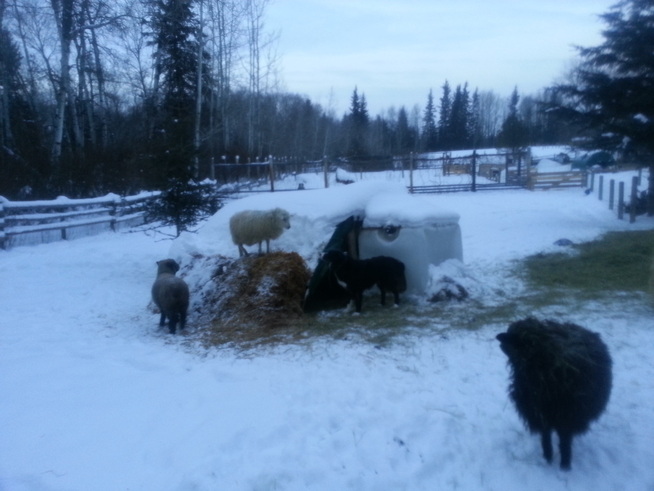 The little ram lamb did not want to bother with Robbie so he jumped up on a hay bale. In the spring when the lambs are born, they climb up to the top of their shelters and jump off, just for fun.
The little ram lamb did not want to bother with Robbie so he jumped up on a hay bale. In the spring when the lambs are born, they climb up to the top of their shelters and jump off, just for fun. Although primitive sheep are easier in some ways, they do not sell as well as meat sheep, unless it is to a buyer who also appreciates their hardiness. Many of the old breeds have excellent wool, like the Icelandics. Their wool has short and long fibers which can be separated and spun independently or spun together for lopi wool, a warm, weather resistant wool.
When it comes to doing things with the primitives, though, they are not so easily managed. They can be wild and crazy and excellent jumpers. I have set a 5 foot gate up only to have a Barbados ewe clear it and take off when I cornered her for examination. I no longer have any Barbados. The Shetland sheep were very small, with wonderful fleece, but little market. The lambs grow quickly even though they are tiny at birth, but they cannot ever catch up to the commercial sheep. Sold by the pound on the hoof, they only would bring half of what a commercial lamb would. Also they are best bred after a year to give the lambs time to grow, so the extra time means less frequent lambing. Still, there are some who work within these boundaries and love the sheep. I no longer have an Shetlands.
Ideally the best sheep would be a primitive breed that is large, produces large lambs that can be bred in year 1 and also has great fleece. Cotswolds almost fit that description, but like Angora goats, have been bred for fiber overly much, and are no longer the hardy animals they once were. The hunt is still on for that type of sheep. In the meantime, this little lamb, an Icelandic, Shetland, Karakul cross, is thinking out of the box. He is cute as a button, though tiny compared to the others without Shetland genes. And he is having some fun!

 RSS Feed
RSS Feed